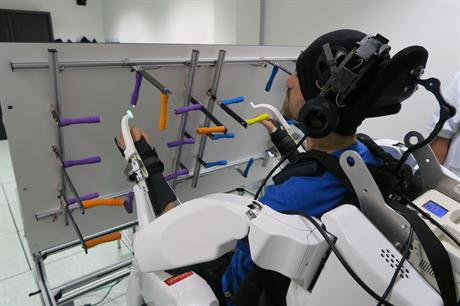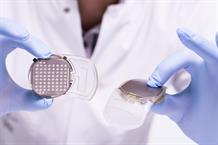Real-time and wireless technology
Tetraplegia is caused by a lesion on the spinal cord that prevents the nervous system from controlling all four limbs. To limit dependency and facilitate the mobility of patients with this severe disability, medical doctors, physicians and researchers at Clinatec, the CEA laboratory in Grenoble operated with the Grenoble university hospital, have developed a device to control a four-limb exoskeleton that records and decodes brain signals.
The major innovation in this device is its ability to provide chronic high-resolution recording of the brain's electrical activity. This activity related to the moving intention is transmitted it in real-time wirelessly to a computer for decoding in order to control the movements of the exoskeleton's four limbs.
Alim-Louis Benabid, neurosurgeon, Professor Emeritus at Université Grenoble Alpes, lead author of the publication in The Lancet Neurology journal, and Chair of the Board at Clinatec, worked with a team to design the implantable device (WIMAGINE®) that collects brain signals in the sensorimotor cortex emitted when an individual imagines moving. The tetraplegic patient can move by mentally controlling the exoskeleton: external controls are unnecessary. According to Professor Benabid, "This device is an important step forward in helping people with disabilities become self-sufficient. We are extremely proud of this proof of concept and are already considering new applications to make everyday life easier for people with severe motor disabilities."
From technology to clinical trials
With the authorisation of regulatory authorities, Clinatec is conducting a clinical trial to test the device on a 28-year-old tetraplegic patient with a lesion on his spinal cord. The results were published on 3 October 2019 in The Lancet Neurology journal. Two WIMAGINE® devices were implanted in June 2017 on the right and left sides of the upper sensorimotor area of the brain, above the patient's dura mater. The operation at Clinatec was performed by Professor Stephan Chabardes, co-author of the publication, a neurosurgeon at CHU Grenoble Alpes, and Medical Director at Clinatec. "Contributing to the success of this project by providing medical care to the patient was an incredible experience," Dr. Chabardes explains.

The four-limb exoskeleton controlled by the patient during the BCI project at Clinatec ©Clinatec
Since the operation, the patient has spent 27 months performing various types of exercises to practice controlling the exoskeleton. He practices in virtual environments with the exoskeleton avatar at home three times a week and works directly with the exoskeleton at Clinatec one week every month. When fitted with the suspended exoskeleton, he is able to take several successive steps and control his two upper limbs in three dimensions. He also can rotate his wrists while sitting or standing.
This patient will continue his involvement in this research protocol at Clinatec and will actively participate in future developments. This proof of concept for a neuroprosthetic providing this level of freedom will open the door to new applications for use at home by patients in their everyday lives. The Clinatec team is working on integrating new effectors, such as a wheelchair, and developing even robust and more precise algorithms to perform more complex movements, with the hope of later enabling tasks such as holding an object. Three other tetraplegic patients will also be included in this clinical trial in the coming years.
.jpg)
@Juliette Treillet
Recording brain signals to recreate movement - the WIMAGINE® device

© La brèche

Recording electrical activity in the sensorimotor cortex required development of an innovative implantable medical device: WIMAGINE®. The device was designed for semi-invasive implantation in the cranium in order to record electrocorticograms (ECoG) over the long term using an array of 64 electrodes in contact with the dura mater.
Electronic boards contain the electrocorticogram acquisition and digitalization systems, designed by microelectronics experts at CEA-Leti, together with a remote power supply and wireless data-transfer systems via secure radio link to an external base station. The implant packaging was designed to ensure long-term biocompatibility and safety. The implants have undergone rigorous testing to verify their compliance with standards required by EU Directives for Active Implantable Medical Devices.
The electrocorticograms recorded are then decoded in real-time to predict the deliberate movement imagined by the patient and then, for example, to control the corresponding limb of an exoskeleton. Decoding electrocorticograms required the development of highly sophisticated algorithms based on Artificial Intelligence methods (Machine Learning) and software to be able to control the movements of the exoskeleton in real-time. The WIMAGINE® device also involved research engineers from CEA-List, the institute specialised in smart digital systems. These developed the four limb exoskeleton based on their reversible actuation and control-command bricks. This design specifically took into account the interaction of a quadriplegic person with the exoskeleton to be able to mobilize it safely.
The long-term goal is to identify fields in which the brain-machine interface could be used to create compensatory systems for various types of motor disabilities and give patients more independence in their everyday lives, for example, by driving a wheelchair or controlling an articulated arm.
CEA-Grenoble
The CEA-Grenoble centre is located in an area with a wealth of scientific and industrial expertise, and focuses most of its research on microelectronics, new energy sources, and medical technologies for building a society of the future.
Clinatec, the Edmond J. Safra Biomedical Research Centre

The Edmond J. Safra Biomedical Research Centre was co-founded by Professor Alim-Louis Benabid and Jean Therme in 2012, with the aim of designing, developing, and providing physicians with new technological systems for the diagnosis and treatment of neurodegenerative diseases, cancers and motor disabilities. Its staff of 70 includes experts in robotics, mathematicians, physicists, electronics engineers, computer scientists, biologists, neurologists, surgeons and healthcare staff from public institutions (CEA, CHU Grenoble Alpes teaching hospital).
CHU Grenoble Alpes
CHU Grenoble-Alpes (CHUGA) is a university hospital ranked in the top ten hospitals in France and the leading healthcare institution for the Alpine Arc, a region with a population of 2 million. CHUGA has 10,000 staff, including over 2,500 doctors, and works with over 1 million patients every year, providing local medical care and surgery as well as highly specialised treatments, and 24-hour emergency care for all.
CHUGA offers high-level performance in a number of medical specialities together with cutting-edge technological equipment, and has a number of areas of excellence in both healthcare and research. It is also investing in the future by training all its professionals in order to develop the medical profession for the 21st century.
With a central budget of €713 million in 2018 and an investment budget of €52 million, CHUGA is also a major economic player. It is the leading employer in the Grenoble region, and bolsters the local area through its healthcare, teaching and research activities, as well as the disposable income it redistributes, the goods and services it acquires and the investments it makes.
The Clinatec Endowment Fund
In order to accelerate research and innovation transfer for patients, CEA innovating its funding methods. In 2014, it initiated the Clinatec Endowment Fund, an independent body. The fund is directed by Thierry Bosc with a mission to raise private funds for Clinatec research programmes. In 2019, Thibault Lanxade was appointed to take over from Alain Mérieux in heading up the campaign committee. Thanks to everyone's hard work, €17 million has been raised and injected into Clinatec projects.
A large number of sponsor companies and foundations support Clinatec and its projects, and we would like to thank them here: Edmond J. Safra Foundation, Covéa, Klésia, AG2R La Mondiale, Altran, l'Auxiliaire, BioMérieux, Crédit Agricole Centre-Est, Crédit Agricole Sud Rhône-Alpes, Expleo, Fondation Arts et Métiers, Fondation EDF, Fondation Maison de la Chimie, France Parkinson, ARaymond, Gefluc, Groupe Servier, IPSEN, Kartesis, Michael J. Fox Foundation, M
SA, Rotary Club, Lyons Club, Soroptimist, Sydo...
Université Grenoble Alpes - UGA
Université Grenoble Alpes was born out of the merger of Grenoble's three universities, and is a key player in higher education and research in France. In an increasingly competitive world, UGA aims to meet the current and future challenges facing universities, and to develop its profile and attractiveness on the international stage. Thanks to its 80 laboratories, in partnership with the site's research bodies and leading institutions, research at UGA has been increasing its interdisciplinary activities in order to be at the cutting edge of innovation. Its range of available training opportunities also covers all disciplines. UGA is now able to offer its 48,000 students cross-cutting study programmes and facilitate transfers between disciplines.